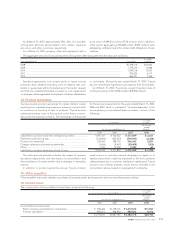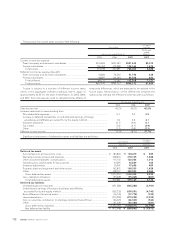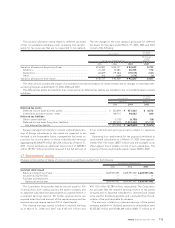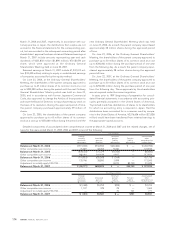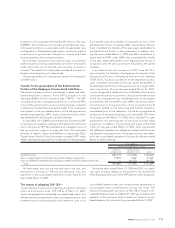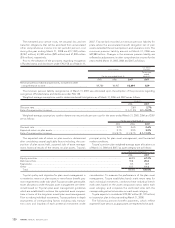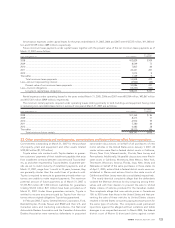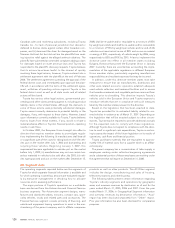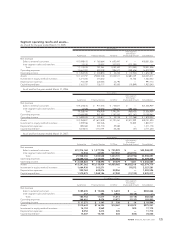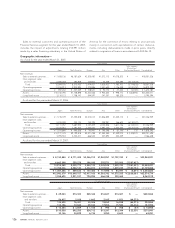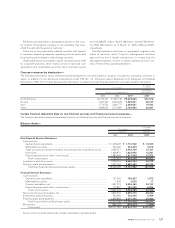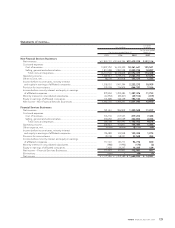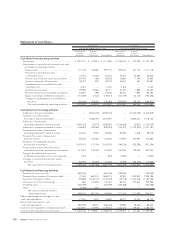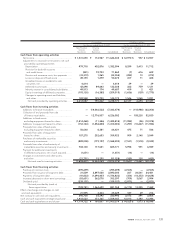Toyota 2007 Annual Report Download - page 123
Download and view the complete annual report
Please find page 123 of the 2007 Toyota annual report below. You can navigate through the pages in the report by either clicking on the pages listed below, or by using the keyword search tool below to find specific information within the annual report.
ANNUAL REPORT 2007 121
Postretirement benefits other than pensions
and postemployment benefits—
Toyota’s U.S. subsidiaries provide certain health care and life
insurance benefits to eligible retired employees. In addition,
Toyota provides benefits to certain former or inactive employ-
ees after employment, but before retirement. These benefits
are currently unfunded and provided through various insurance
companies and health care providers. The costs of these bene-
fits are recognized over the period the employee provides
credited service to Toyota. Toyota’s obligations under these
arrangements are not material.
U.S. dollars
Years ending March 31, Yen in millions in millions
2008 ............................................................................................................................................................... ¥ 74,946 $ 635
2009 ............................................................................................................................................................... 82,650 700
2010 ............................................................................................................................................................... 79,124 670
2011 ............................................................................................................................................................... 76,904 652
2012 ............................................................................................................................................................... 73,085 619
from 2013 to 2017......................................................................................................................................... 375,621 3,182
Total .......................................................................................................................................................... ¥762,330 $6,458
Toyota employs derivative financial instruments, including for-
eign exchange forward contracts, foreign currency options,
interest rate swaps, interest rate currency swap agreements and
interest rate options to manage its exposure to fluctuations in
interest rates and foreign currency exchange rates. Toyota does
not use derivatives for speculation or trading.
Fair value hedges—
Toyota enters into interest rate swaps, and interest rate curren-
cy swap agreements mainly to convert its fixed-rate debt to
variable-rate debt. Toyota uses interest rate swap agreements
in managing its exposure to interest rate fluctuations. Interest
rate swap agreements are executed as either an integral part of
specific debt transactions or on a portfolio basis. Toyota uses
interest rate currency swap agreements to entirely hedge exposure
to currency exchange rate fluctuations on principal and interest
payments for borrowings denominated in foreign currencies.
Notes and loans payable issued in foreign currencies are hedged
by concurrently executing interest rate currency swap agree-
ments, which involve the exchange of foreign currency principal
and interest obligations for each functional currency obligations
at agreed-upon currency exchange and interest rates.
For the years ended March 31, 2005, 2006 and 2007, the
ineffective portion of Toyota’s fair value hedge relationships
which are included in cost of financing operations in the accom-
panying consolidated statements of income were not material.
For fair value hedging relationships, the components of each
derivative’s gain or loss are included in the assessment of
hedge effectiveness.
Undesignated derivative financial instruments—
Toyota uses foreign exchange forward contracts, foreign cur-
rency options, interest rate swaps, interest rate currency swap
agreements, and interest rate options, to manage its exposure
to foreign currency exchange rate fluctuations and interest rate
fluctuations from an economic perspective, and which Toyota
is unable or has elected not to apply hedge accounting.
Unrealized gains or losses on these derivative instruments are
reported in the cost of financing operations and foreign
exchange gain, net in the accompanying consolidated state-
ments of income together with realized gains or losses on those
derivative instruments.
20. Derivative financial instruments:
Toyota has certain financial instruments, including financial
assets and liabilities and off-balance sheet financial instruments
which arose in the normal course of business. These financial
instruments are executed with creditworthy financial institutions,
and virtually all foreign currency contracts are denominated in
U.S. dollars, euros and other currencies of major industrialized
countries. Financial instruments involve, to varying degrees,
market risk as instruments are subject to price fluctuations, and
elements of credit risk in the event a counterparty should
default. In the unlikely event the counterparties fail to meet the
contractual terms of a foreign currency or an interest rate instrument,
Toyota’s risk is limited to the fair value of the instrument. Although
Toyota may be exposed to losses in the event of non-perfor-
mance by counterparties on financial instruments, it does not
anticipate significant losses due to the nature of its counterpar-
ties. Counterparties to Toyota’s financial instruments represent,
in general, international financial institutions. Additionally,
Toyota does not have a significant exposure to any individual
counterparty. Based on the creditworthiness of these financial
institutions, collateral is generally not required of the counter-
parties or of Toyota. Toyota believes that the overall credit risk
related to its financial instruments is not significant.
21. Other financial instruments:


